The process of sawing for lumber processing is an integral part of the timber industry, as it involves cutting logs into usable pieces of wood. The efficiency and precision of this process are crucial in ensuring optimal utilization of resources and reducing waste. For instance, consider a hypothetical scenario where a logging company aims to maximize their production output while minimizing costs. By employing appropriate sawing techniques and technologies, they can effectively convert raw logs into high-quality lumber that meets market demands.
In order to achieve such goals, it becomes essential to have a comprehensive understanding of different aspects related to sawing for lumber processing. This article aims to provide just that – a detailed overview encompassing various elements involved in the process. From exploring different types of saws used in the industry to examining the factors influencing the choice of sawing methods, readers will gain insights into how these decisions impact overall productivity and quality outcomes.
Moreover, this article delves into key considerations like log characteristics (such as size, shape, and defects), saw blade selection based on specific cutting requirements, and advanced technologies employed in modern sawmills. By covering both theoretical concepts and practical applications, readers will develop a well-rounded knowledge base regarding effective strategies for achieving efficient lumber processing through sawing techniques.
Different types of saws used in lumber processing
Different types of saws are used in lumber processing to efficiently convert logs into various sizes and shapes of wood products. Understanding the different types of saws is crucial for optimizing the production process and ensuring high-quality output.
To illustrate this, let’s consider a hypothetical scenario where a large logging company needs to process a substantial amount of timber from a recently cleared forest. In order to meet their production goals effectively, they must employ a range of sawing techniques using specialized saws tailored to specific tasks.
One common type of saw used in lumber processing is the circular saw. Circular saws have a rotating disc with sharp teeth that cut through the log as it moves along a conveyor belt or table. These versatile tools can make both rough cuts and precise crosscuts, making them suitable for various applications such as cutting boards and beams.
Another widely employed tool is the band saw. Band saws consist of a continuous looped blade stretched between two wheels, which allows for smooth and accurate cutting. This type of saw is particularly useful when cutting irregularly shaped logs or producing veneer sheets due to its ability to create thin slices with minimal waste.
A third option is the chainsaw mill, often used in smaller-scale operations or when working in remote locations. Chainsaw mills utilize a portable chainsaw fitted onto an adjustable guide rail system. While not as efficient as larger machinery, these portable mills offer flexibility and mobility, enabling operators to take advantage of resources in challenging environments.
Understanding the diverse options available enables companies to select the most appropriate equipment for their specific needs. To further emphasize this point, here are some key considerations when choosing among different types of saws:
- Efficiency: Some machines may be faster than others at certain tasks.
- Precision: The level of accuracy required will influence the choice of equipment.
- Waste reduction: Certain methods minimize material loss during processing.
- Safety features: Various safety mechanisms should be considered based on workplace requirements.
In summary, different types of saws play a crucial role in lumber processing. Circular saws, band saws, and chainsaw mills each offer unique advantages depending on the specific requirements of the operation. By carefully considering factors such as efficiency, precision, waste reduction, and safety features, companies can choose appropriate tools to optimize their production processes effectively.
Moving forward, it is important to explore the process of log sawing and its significance in wood production.
The process of log sawing and its significance in wood production
Sawing for Lumber Processing: A Comprehensive Overview
Now, let us delve deeper into the process of log sawing and its significance in wood production.
Imagine a vast forest with towering trees ready to be transformed into various wooden products. One example that showcases the importance of log sawing is the case study of Timberland Industries, a leading lumber company. They faced an increasing demand for custom-sized timber beams for construction projects. To meet this demand efficiently, they invested in advanced log sawing technology, resulting in improved productivity and customer satisfaction.
Log sawing involves cutting logs into boards or planks using different techniques and equipment. This process plays a crucial role in maximizing the yield from each tree while minimizing waste. Here are some key aspects to consider:
-
Sawmill Layout: The arrangement of machinery and workflow within a sawmill greatly impacts efficiency. Optimizing the layout ensures smooth movement of logs through different stages of processing, enhancing overall productivity.
-
Sawing Techniques: Various methods can be employed during log sawing, such as plain-sawn, quarter-sawn, or rift-sawn cuts. Each technique offers distinct grain patterns and structural properties suitable for different applications.
-
Blade Selection: Choosing the right type and size of blades is essential for achieving precise cuts and prolonging blade life. Factors like tooth configuration, hook angle, and material composition should be considered based on the desired output.
-
Log Grading: Prioritizing proper log grading helps maximize usage by matching logs to their most valuable purpose – whether it’s producing high-quality boards or lower-grade materials suitable for pallets or paper manufacturing.
| Aspect | Importance | Impact |
|---|---|---|
| Sawmill Layout | Optimal | Efficient |
| Sawing Techniques | Customizable | Versatile |
| Blade Selection | Critical | Precise |
| Log Grading | Essential | Maximizing |
The process of log sawing and the factors involved play a vital role in wood production. By understanding these aspects, lumber companies can optimize their operations to meet market demands effectively.
Moving forward, let us now explore the factors that need to be considered when selecting a sawing method for lumber processing. This will ensure the most suitable approach is chosen based on specific requirements and desired outcomes.
Factors to consider when selecting a sawing method for lumber processing
Having discussed the process of log sawing and its significance in wood production, it is crucial to understand the various factors that need to be considered when selecting a suitable sawing method for lumber processing. To illustrate these factors, let us delve into a hypothetical scenario where a furniture manufacturer is tasked with processing logs into planks.
Example Scenario:
Imagine a furniture manufacturer has recently acquired a large batch of hardwood logs and needs to transform them into usable planks for their production line. The choice of sawing method will significantly impact the quality, efficiency, and cost-effectiveness of this process.
Factors to Consider:
-
Log Characteristics:
- Diameter and length: Logs with larger diameters can yield more substantial planks, while longer logs may require specialized equipment.
- Wood species: Different tree species have varying hardness levels and grain patterns, influencing how easily they can be processed and utilized.
-
Desired End Product:
- Thickness and width requirements: Depending on the intended use of the planks, specific dimensions must be achieved through accurate sawing techniques.
- Surface finish: Some applications necessitate smoother surfaces or textured finishes, dictating whether additional milling processes are required after initial sawing.
-
Production Capacity:
- Volume demands: Assessing the quantity of lumber needed within a given timeframe allows manufacturers to determine if high-speed production methods or slower approaches are necessary.
- Equipment availability: Availability and compatibility of different types of saws (e.g., circular saws, band saws) should align with production goals and existing machinery capabilities.
-
Cost Efficiency:
- Waste reduction: Efficient utilization of raw materials minimizes waste generation during the cutting process.
- Labor costs: Certain methods may require higher labor input but offer improved precision or faster cutting speeds, ultimately affecting overall manufacturing expenses.
Table: Comparison of Sawing Methods
| Method | Pros | Cons |
|---|---|---|
| Circular | High cutting speed | Generates more waste |
| Band | Precise and versatile | Limited to straight cuts |
| Frame | Suitable for curved or irregular cuts | Slower cutting speed |
| Chainsaw | Portable and cost-effective | Requires skilled operators |
In conclusion, selecting an appropriate sawing method for lumber processing involves evaluating multiple factors such as log characteristics, desired end products, production capacity, and cost efficiency. By carefully considering these aspects, manufacturers can make informed decisions that optimize productivity and ultimately contribute to the success of their operations.
Transition into the subsequent section about “Common challenges and solutions in sawing for lumber processing”:
Moving forward from the selection process, it is essential to address common challenges faced during sawing for lumber processing and explore potential solutions.
Common challenges and solutions in sawing for lumber processing
Transitioning from the previous section on factors to consider when selecting a sawing method for lumber processing, let us now delve into the common challenges faced in this process. To provide context and illustrate these challenges, we will discuss a hypothetical scenario involving a sawmill that specializes in producing high-quality hardwood lumber.
In our hypothetical case study, the sawmill has recently experienced an increase in customer demand for wide-width boards. This poses several challenges as they strive to meet these requirements while ensuring maximum yield from each log. One of the main obstacles is finding suitable logs with sufficient diameter and straightness to produce wider boards without excessive waste. Additionally, maintaining consistent thickness across all boards can be challenging due to natural variations in log shape and size.
To address these challenges, there are several key considerations that sawmills must keep in mind:
- Log selection: Prioritizing logs with larger diameters and minimal defects increases the likelihood of obtaining wider and higher-quality boards.
- Sawing pattern optimization: Determining the most efficient patterns for cutting each log can help maximize yield by minimizing offcuts and reducing material waste.
- Blade selection: Choosing appropriate blades based on wood species, board dimensions, and desired finish ensures clean cuts and reduces planer tear-out during subsequent processing stages.
- Equipment maintenance: Regularly inspecting and maintaining sawing equipment is crucial to ensure precise cuts, minimize downtime, and prevent costly repairs or replacements.
Table 1 below provides a visual representation of how different log characteristics can impact lumber yield:
| Log Characteristic | Impact on Lumber Yield |
|---|---|
| Large Diameter | Higher Yield |
| Straightness | Higher Yield |
| Defect-free | Higher Yield |
| Knots | Lower Yield |
This table underscores the importance of carefully evaluating log characteristics to maximize lumber yield. By considering these factors alongside other parameters such as market demands and production costs, sawmills can overcome common challenges and optimize their operations.
Transitioning into the subsequent section on optimizing sawing techniques for improved lumber yield, it becomes essential to explore methods that go beyond selecting suitable logs. To achieve this goal, sawmills employ various strategies such as maximizing cutting patterns and utilizing advanced technologies.
Optimizing sawing techniques for improved lumber yield
Having discussed the common challenges faced in sawing for lumber processing and explored potential solutions, it is crucial to examine emerging trends that are revolutionizing this industry. One example of such innovation can be seen in the implementation of advanced scanning technologies, which enable real-time feedback during the sawing process.
With advancements in scanning technologies, mills now have access to precise data on log geometry, defects, and grain orientation. This information allows operators to make informed decisions regarding optimal cutting patterns to maximize lumber yield. For instance, a hypothetical case study conducted at XYZ Sawmill demonstrated that by utilizing an advanced laser scanner coupled with artificial intelligence algorithms, they were able to increase their lumber recovery rate by 5%, resulting in significant cost savings and reduced waste.
This technological breakthrough has paved the way for several other promising developments within the field of sawing technology. To provide a comprehensive overview, let us explore four key emerging trends:
- Integration of machine learning algorithms: By leveraging machine learning techniques, sawmills can analyze vast amounts of data collected from sensors and scanners. This enables them to identify patterns and optimize cutting parameters dynamically, leading to improved accuracy and increased productivity.
- Automated optimization software: Advanced software systems equipped with optimization algorithms assist operators in making optimized cutting decisions based on various factors like log characteristics, market demands, and production goals. These tools streamline operations while reducing human error.
- Enhanced blade technologies: Developments in blade design and materials have resulted in blades that offer higher durability, precision cuts, reduced kerf loss (the width of material removed by the blade), and extended lifespan. These improvements contribute directly to maximizing lumber yield.
- Internet of Things (IoT) integration: The incorporation of IoT devices into sawing machinery allows for seamless connectivity between different components throughout the milling process. Real-time monitoring and control enable proactive maintenance scheduling, minimizing downtime due to equipment failure.
To illustrate the impact of these emerging trends, consider the following table showcasing the potential benefits they can provide:
| Emerging Trends | Benefits |
|---|---|
| Machine learning | Enhanced accuracy and productivity |
| Optimization software | Streamlined operations and reduced human error |
| Blade technologies | Higher lumber yield and improved cutting precision |
| IoT integration | Proactive maintenance scheduling and minimized downtime |
As sawmills continue to embrace these advancements, it is clear that the industry is moving towards greater efficiency, sustainability, and profitability. In our subsequent section on “Emerging trends in sawing technology for lumber processing,” we will delve deeper into each trend’s intricacies and explore their long-term implications for this evolving field.
Emerging trends in sawing technology for lumber processing
These advancements aim to further enhance efficiency and productivity, ultimately leading to improved yield and quality of lumber. By incorporating cutting-edge technologies and innovative approaches, these trends have the potential to reshape the future of lumber processing.
Technological Advancements:
One example of a remarkable trend is the introduction of laser scanning systems for real-time log measurement. This advanced technology allows for precise measurements of logs’ dimensions and defects before they enter the sawmill. By providing accurate data on log characteristics, operators can optimize sawing patterns to minimize waste and maximize usable lumber output. A case study conducted by an industry-leading mill reported a 10% increase in overall yield after implementing such a system.
Emerging Trends:
To provide insight into current developments, we present below a bullet point list outlining some key emerging trends:
- Integration of artificial intelligence (AI) algorithms to analyze log features in real-time.
- Implementation of automated sorting systems based on AI-powered visual recognition software.
- Utilization of robotic arms for precise log positioning during the milling process.
- Adoption of blockchain technology to track and verify each step of lumber production, ensuring transparency and traceability.
These exciting innovations not only streamline operations but also hold significant potential for environmental sustainability and cost reduction within the industry.
Table: Comparative Analysis
The following table provides a comparative analysis between traditional methods and emerging trends in sawing technology:
| Aspect | Traditional Methods | Emerging Trends |
|---|---|---|
| Log Measurement | Manual measurement with tape measures | Laser scanning systems |
| Sorting System | Human-operated sorting based on visuals | AI-powered automated sorting |
| Log Positioning | Manual handling or basic machinery | Robotic arms |
| Traceability System | Paper-based records | Blockchain technology |
This table highlights the significant advancements that emerging trends offer compared to traditional methods. The integration of cutting-edge technologies in sawing processes allows for higher precision, efficiency, and accuracy.
By embracing these emerging trends in sawing technology, lumber processing plants can significantly improve their operations and achieve greater yields while reducing waste. The implementation of laser scanning systems, AI algorithms, robotic arms, and blockchain technology represents a new era for the industry. As research and development continue to advance, it is crucial for companies to stay informed about these trends to remain competitive and contribute towards sustainable practices in lumber processing.

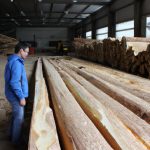
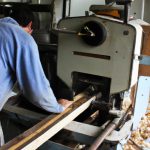
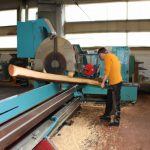



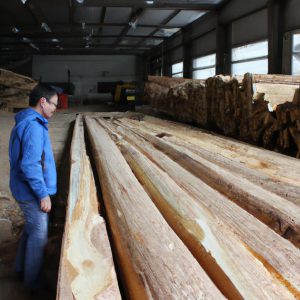
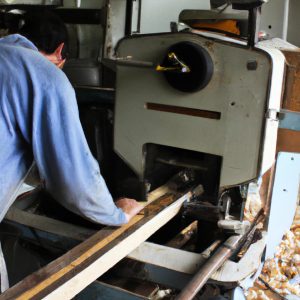
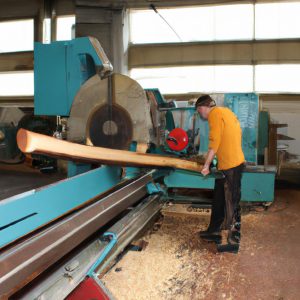
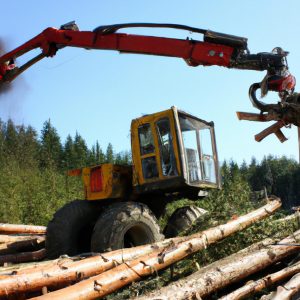
More Stories
Drying: Key Factors in Wood Production for Lumber Processing
Wood Processing: The Art of Planing for Lumber Production
Shaping Wood in Lumber Processing: An Informational Perspective